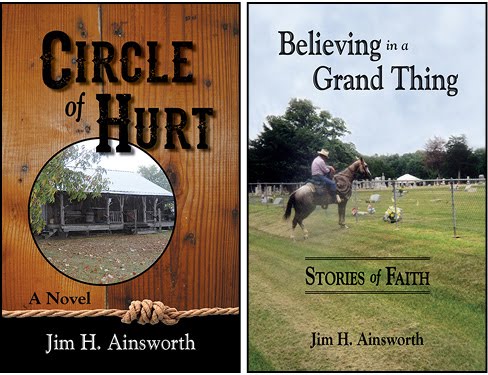I didn’t really put all the Godwinks together at first, either.
Not for a long time. Here’s another recap: Jerald and Saddle Songs/Dorrance and
Farnsworth at Cowboy Hall of Fame/Moline painting on Cowboy Magazine of Don
Edwards/Moline in Yippy Yi Yea along with Buck Taylor. Just a string of coincidences,
right? Then along comes another issue of Cowboy.
A painting of Waddie Mitchell (the Bard in Bard and Balladeer) graced the
cover.
Inside, Waddie, a veteran Nevada buckaroo of twenty-six
years, tells us the difference between buckaroos and cowboys. He, along with
Utah folklorist Hal Cannon, established the first cowboy poetry gathering in
Elko, Nevada in 1985.
A few pages later, there is an article on Tom and Bill
Dorrance and Ray Hunt. Yes, the same Tom Dorrance we had met at the Cowboy Hall
of Fame six months earlier. Again, not too big a coincidence, but another
connecting thread.
Yippy Yi Yea’s
next issue came along only a few days later. There was a beautifully tooled
saddle on the front and an inset picture of Don Edwards. Inside was an article,
complete with pictures of Don and his Sevenshoux Ranch in Weatherford.
The saddle on the cover sat in his living room. Guess who
made it? Bob Moline. There is also a picture of the Wrangler award he received
from the Cowboy Hall of Fame. On one of his walls hangs a rawhide riata made by
his friend and traveling partner, Waddie Mitchell (the Bard part of The Bard
and The Balladeer).
In the article, Don refers to himself as a cowboy Leon
Redbone. I learned that he once played at Six Flags Over Texas when it first
opened and was a regular and once part-owner of the White Elephant Saloon, one
of my favorite watering holes. I am not there often, but I try to visit
whenever I am in the Fort Worth Stockyards area. There is a mural of Don on one
of the walls in the saloon.
I admit that I may be making too much of a series of
coincidences, and I did not think much about what was happening at the time. But I
did feel that I needed to meet Don Edwards. I wasn’t sure how that
would come about.
I sort of chalked it all up to fortuitous events and moved
on with business as usual. Then someone put a flier on my desk in my Dallas
office about the Fort Worth Cowboy Gathering organized primarily by Red
Steagall. Don Edwards was going to perform.
I met Don briefly at the Fort Worth gathering and
found him friendly and down to earth. I sort of knew that this was not my last
encounter.At the time,I was in charge of
annual conferences and training for the financial services firm where I worked.
I began to look at the stockyards through new eyes. Plans began to formulate
for the next conference.
Cowboy poetry was just taking off in those days, and
guys like Waddie Mitchell and Baxter Black were appearing on late night talk
shows after appearing at gatherings like the ones in Elko, Nevada, or Alpine,
Texas.
I asked my associate Greg Aden to look into booking The Bard
and the Balladeer. My first mailing from their recording company and agents, Western
Jubilee Recording Company in Colorado Springs, included a pamphlet with a picture of
Richard Farnsworth (yes, the same one we met at the Cowboy Hall of Fame)
endorsing their music.
I made a little research trip of my own to the Worthington Hotel,
checking out ways we could entertain a bunch of CPA's and stockbrokers who hailed from
all over the country. There was a large group from the Baltimore area and a few
from California and other places that I feared might not appreciate my bringing
them into the cowboy lifestyle for a business conference.
On my fact-finding mission, I took along copies of all the
magazines I have described. Satisfied that we had chosen the right hotel in the
right town, I drove out to a peaceful middle class suburb. I knew where I was
going, but did not know why, and I was going unannounced.
I stopped in the
driveway of a nice, but non-pretentious house and knocked on the door of a
small building in the backyard. I knew that it was an artist’s studio because I
had seen pictures of it in Yippy Yi Yea.
God winked again when Bob Moline opened the door.


